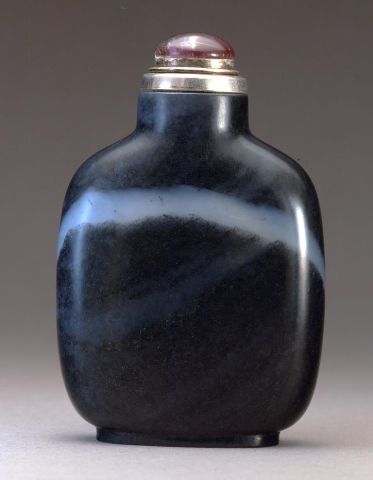
Bottle ID: 170
BLACK WITH LIGHT GRAY BAND
Date: 1750-1800
Height: 65 mm
Nephrite, very well hollowed, of dark gray-black color with a white band running concentrically around the body, rising to a point on one side, of rectangular form with sloping shoulders, with a concave mouth and neat footrim.
Similar Examples:
Crane Collection no. 186
Moss, Hugh, Victor Graham and Ka bo Tsang. The Art of the Chinese Snuff Bottle - The J & J Collection, 1993, Vol. I, pp. 114-115, no. 54.
Holden. Rachelle R. Rivers and Mountains Far From the World - The Rachelle R. Holden Collection, 1994, pp. 268-269, no. 116.
Sotheby's, New York, September 15, 1998, lot 210, The Neal W. and Frances R. Hunter Collection.
Sotheby's, New York, September 14, 2010, lot 69, The Joe Grimberg Collection.
Provenance:
Robert Hall
Exhibited:
Annual Convention ICSBS New York, November 2013
There is a small group of bottles and carvings all produced from the same type of black nephrite used to fashion this bottle. The stone is predominately black with inclusions varying from dark gray to lighter shades including white. Many of the bottles and carvings are carved in the style known to snuff bottle collectors as the Suzhou School; a school of carving where the carver utilizes the inclusions to highlight the subject matter, often to great effect. Very few of these "black" nephrite bottles are left uncarved on the main outer surface, presumably because the stone was full of inclusions to inspire the maker. This bottle, however, begs to be left alone, becoming powerful in its elegance and allowing the strength of the material to be appealing to the collector. It is also extremely tactile in the hand, interestingly have the same soft patination that mutton-fat jade has. It is often quoted that all of these "black" bottles and carvings are manufactured from one single large and unique boulder, making the stone exceptionally rare. Whilst it is true that this material is very rare, it is impossible to say for certainty that the material all derived from one boulder. Within the Suzhou School group most of the "black and white" bottles appear to date from the nineteenth century as they tend to be larger and with carving from that period. This bottle, however, fits very nicely into the eighteenth century and can be compared for dating purposes to the group of plain white jade bottles of precisely this form which are also very well hollowed through a small mouth opening.
< Back to full list
 English
English 中文
中文